Bānṭ – बाँट
Quick Definition: a theme-and-variation type composition played in Benares which typically has a laggi section. Performed in tabla solo and accompaniment.
Literal meaning: division; partition
Bant Example
Below is a well-known bant from Benares, famously played by Anokhelal Misra:
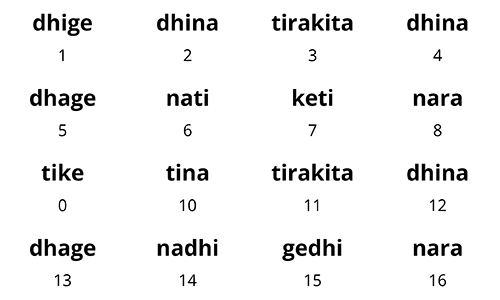
Performed at 1x and 2x speeds:
(from Benares Bant 1)
Introduction to Bant
The Benares bant is a common theme-and-variation type composition, similar to a kayda. Though there may be bant forms outside of Benares, they appear to be rare.
The bant is not well defined, even in Benares. Below I will present Chhotelal Misra’s definition of bant, since he is the source for the Benares material on this site. But other musicians in Benares may have different definitions.
Bant as Kayda, Laggi, or Independent Composition?
Outside of Benares, it is often said that bant is the name that Benarsi tabla players use for Benares kaydas. And for some players in Benares, this may be true. Others say that the bant is a composition made from a laggi.
Accoding to Chhotelal Misra, neither of these descriptions is correct. The most common bants in Benares are independent theme-and-variation type composition.
However, the bant does usually include a laggi-type section, but it is not necessarily made from a laggi. Rather, a laggi can be made from a bant.
The bant has a laggi section
In the example bant above, the first half does not have the typical rhythmic movement of a laggi. But the second half could be played alone as a laggi:
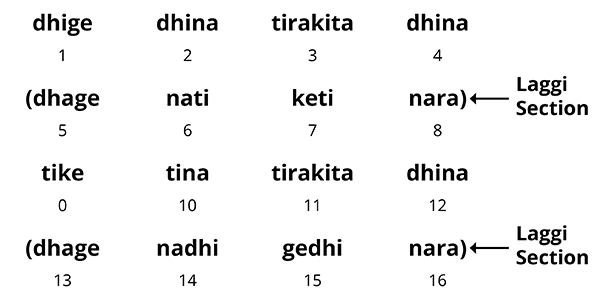
If we play the second half as a variation, it sounds very much like a laggi:

(This variation is included in Chhotelal’s book Tabla Granth, and is played by both Anokhelal and Chhotelal in their solo recordings. )
Below is another famous bant . Here also the second half has a clear laggi feeling:
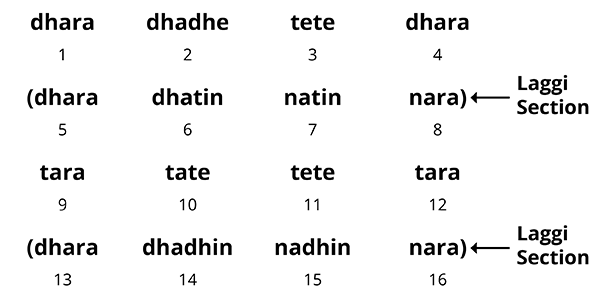
Performed twice:
(from Benares Bant 3)
(Note: Compositions very similar to this bant are played by many players outside of Benares, though it is not usually called a bant.)
And here is a variation made from the second half:

Played 4 times:
Played by itself, the second half is very similar to traditional laggis.
As with so many definitions in classical Indian music, this definition of bant is not without some problems. For example, it is true that there are also some kaydas which have a part with a laggi feel, or which could be played with a laggi feel. And some bants do seem to be clearly based on kaydas from other gharanas.
Also, there are some bants where (to my ear) the laggi component is not as clear as in others. Therefore one could argue there is not always a clear distinction between a bant and a kayda.
However, a laggi-type component is there in most bants, but it is stronger in some than in others.
The Swatantra Bant (Independent Bant)
The most common type of bant in Benares is referred to as the swatantra bant (स्वतंत्र बाँट) or “independent bant”. This is performed in essentially the same way as a kayda. This includes playing in single, double, or quadruple speeds, and developing the bant with variations much like any kayda. Layakari (variations of beat-division) is also sometimes performed with such bants in Benares.
Some swatantra bants are more similar to relas in other gharanas because they can be played at high speed. Below is another bant made famous by Anokhelal. This composition (or similar compositions) is sometimes played as a rela outside of Benares:
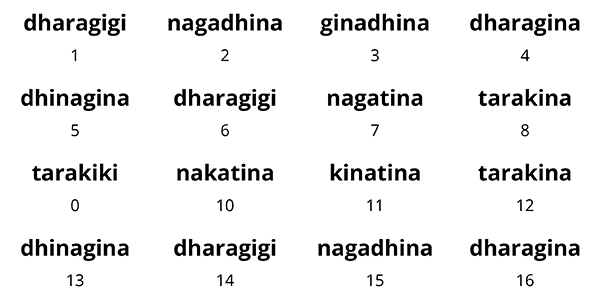
Performed by Anokhelal Misra:
Bant variations may use bols not found in the theme
A significant difference between the performance of a Benares bant and that of a kayda is that variations may include some small bols not found in the bant’s main bol (theme). In this regard, players have more freedom in their improvisations. This is not a requirement of bant development, but it is common.
The Prabandh Bant (Arranged Bant/Bant-to-Rela)
Chhotelal Misra identifies another kind of bant he calls the prabandh bant (प्रबन्ध बाँट), or "arranged bant". This kind of bant is not developed like a kayda, but is used as a kind of introductory chand (groove) for a rela. The rela will have the same rhythmic divisions as the bant.
Bant:

Rela with same rhythmic divisions:
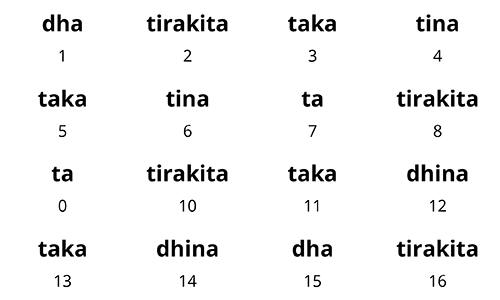
In the following demonstration, the bant is played 4 times followed by the rela 4 times. This sequence is repeated twice:
(from Benares Bant 5)
A rela played on top of a bant in this way can also be done with a swatrantra bant, but it is optional.
This practice of playing some kind of base pattern, followed by a rela with the same division, is common in most gharanas. In other gharanas, however, the bant section would probably have a different name, such as chalan.
References
Gottlieb, Robert S. Solo Tabla Drumming of North India – Its Repertoire, Styles, and Performance Practices. New Delhi: Motilal Benarsidas, 1993. (originally published in 1977)
Misra, Chhote Lal. Tal Prabandh. New Delhi: Kanishka Publishers, 2006. (Hindi)
—. Playing Techniques of Tabla – Banaras Gharana. New Delhi: Kanishka Publishers, 2007.
Shepherd, Francis Ann. Tabla and the Benares Gharana. Unpublished Ph.D. thesis, Wesleyan University, 1976.
Stewart, Rebecca Marie. The Tabla in Perspective. Unpublished Ph.D. thesis, University of California, Los Angeles, 1974.